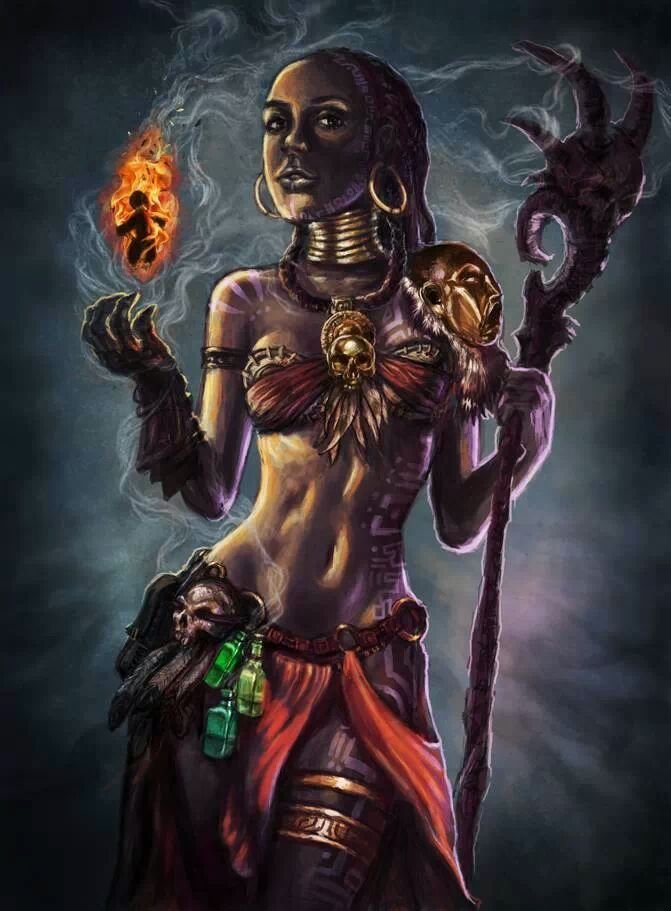 Oya is an orisha from Santeria. The term orisha comes from southern Nigeria and means any of the various minor gods. She lives in the marketplace where she (1) steers the changing fortunes made through business. She is the gatekeeper of the cemetery and leads the spirits of the dead to the threshold. (2) Oya has an extreme love for nature and is the goddess of the Niger River. She's able to summon the dead or wish it away. In fact, she uses the dead to keep her lover Chango in his place since he has a fear of them. Unfortunately, Oya is no stranger to heartbreak and grief. (1) She is also known as the "mother of nine" because she gave birth to nine stillborn babies. To honor and remember her lost children she wears nine different colored scarves around her waist. Oya did however take in unwanted twins who she then raised as her own. (3) Oya is both loved and feared. When released she is the "Savage Warrior" and the "Protective Mother." If treated poorly or spoken down upon she goes from a loving and kind mother to a warrior of destruction. The machete is her most prized possession and weapon. She is known to use a tornado in battle and stands tall next to Chango in battle.
Oya is an orisha from Santeria. The term orisha comes from southern Nigeria and means any of the various minor gods. She lives in the marketplace where she (1) steers the changing fortunes made through business. She is the gatekeeper of the cemetery and leads the spirits of the dead to the threshold. (2) Oya has an extreme love for nature and is the goddess of the Niger River. She's able to summon the dead or wish it away. In fact, she uses the dead to keep her lover Chango in his place since he has a fear of them. Unfortunately, Oya is no stranger to heartbreak and grief. (1) She is also known as the "mother of nine" because she gave birth to nine stillborn babies. To honor and remember her lost children she wears nine different colored scarves around her waist. Oya did however take in unwanted twins who she then raised as her own. (3) Oya is both loved and feared. When released she is the "Savage Warrior" and the "Protective Mother." If treated poorly or spoken down upon she goes from a loving and kind mother to a warrior of destruction. The machete is her most prized possession and weapon. She is known to use a tornado in battle and stands tall next to Chango in battle. I do believe she represents her culter well. Santeria women are known to be intelligent and powerful. I absolutely fell in love with learning about her. A woman that has ties to the dead and drives fear into those who have betrayed her is a woman who deserves some more recognition. She uses the forces of nature to aide her in battle and relies on no one. Oya is an excellent representation of women in that they can be loving and caring, but can rain down on you with her wrath. She is not one to be fucked with. I would actually really enjoy watching a movie about her. She is a powerful and intelligent being all by herself and she is not afraid to hold back.
I do believe she represents her culter well. Santeria women are known to be intelligent and powerful. I absolutely fell in love with learning about her. A woman that has ties to the dead and drives fear into those who have betrayed her is a woman who deserves some more recognition. She uses the forces of nature to aide her in battle and relies on no one. Oya is an excellent representation of women in that they can be loving and caring, but can rain down on you with her wrath. She is not one to be fucked with. I would actually really enjoy watching a movie about her. She is a powerful and intelligent being all by herself and she is not afraid to hold back.
Citations
1. http://santeriachurch.org/the-orishas/oya/
2. https://www.originalbotanica.com/blog/orishas-oya-santeria/
3. http://www.orderwhitemoon.org/goddess/oya-storms/Oya.html



